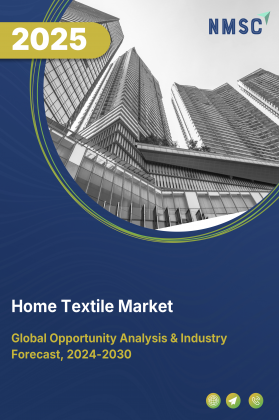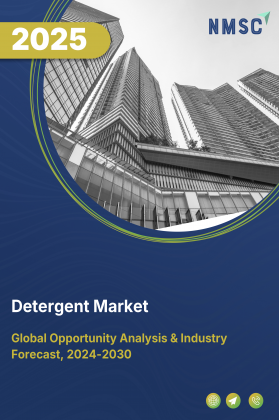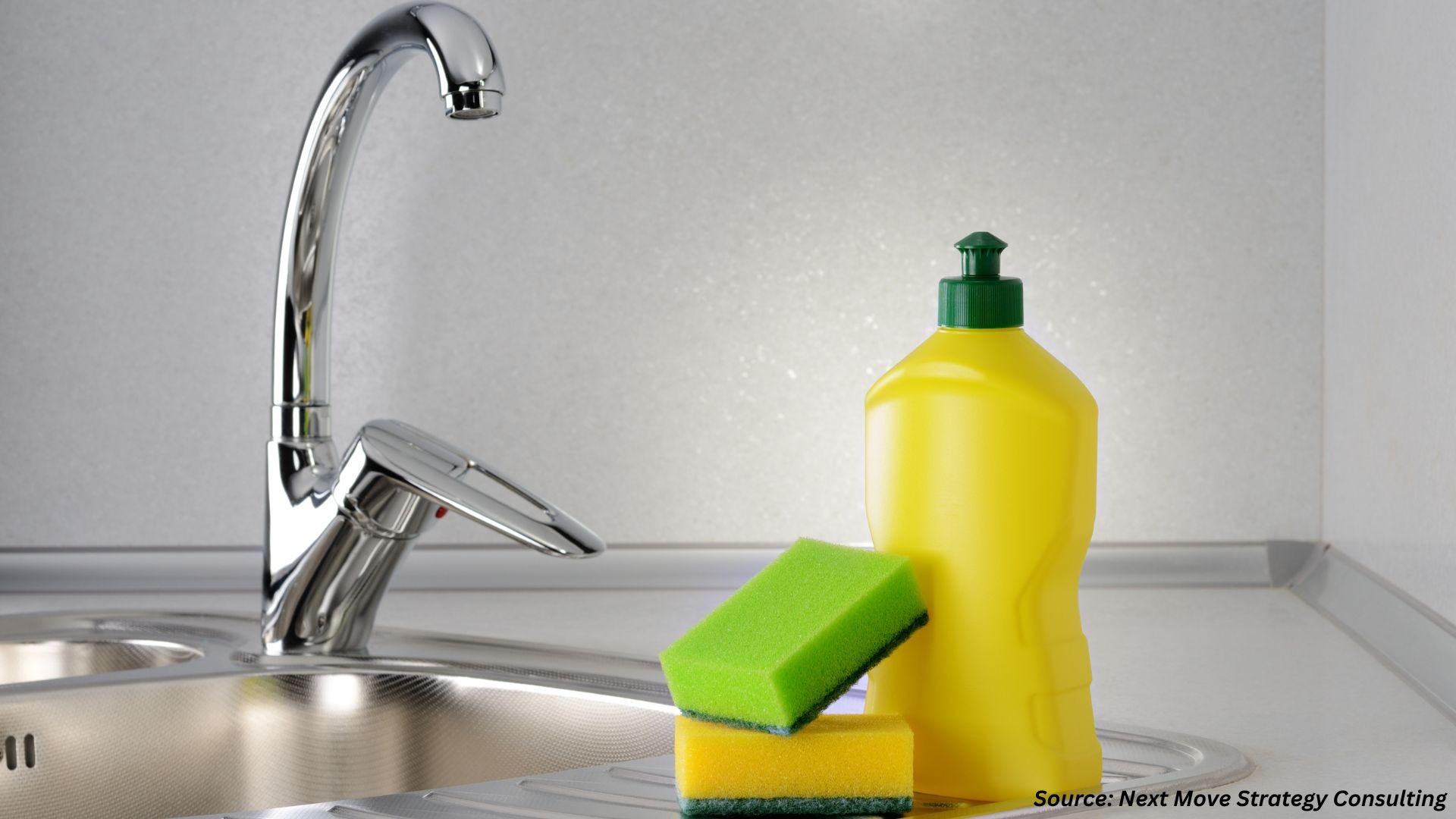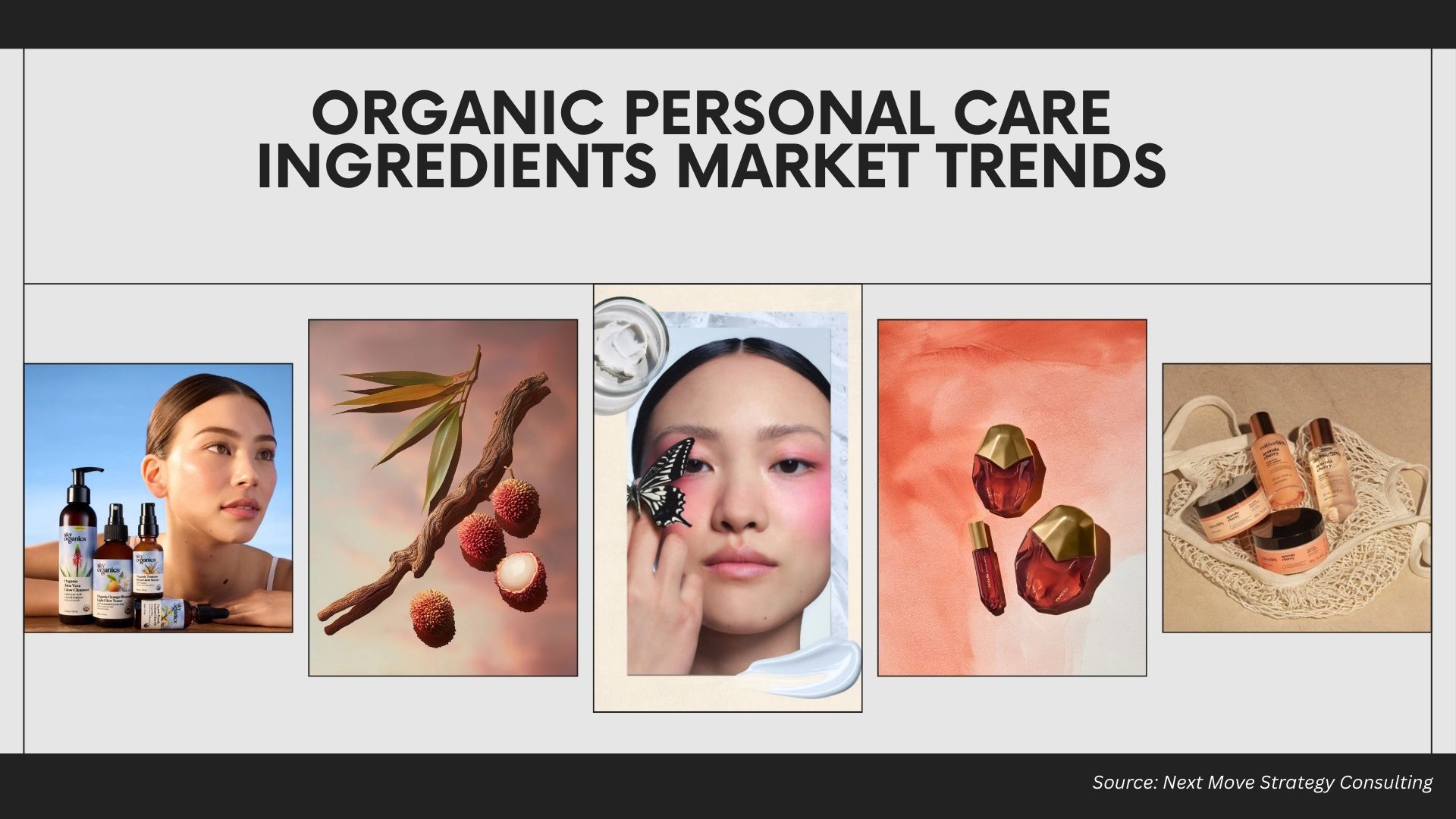
Home Textile Market by Material (Natural Fibers [Cotton, Linen, Silk, Wool, Others], Synthetic Fibers [Polyester, Nylon, Acrylic], Blends, Leather), by Product Type (Bed & Bedding, Bath Textiles, Kitchen & Dining Textiles, Living Room Textiles, Floor Coverings, Curtains & Drapes, Others), by Price (Economy, Mid-Range, Luxury), by Distribution Channel (Offline, Online, Direct Sales)– Global Opportunity Analysis and Industry Forecast, 2025–2030.
Industry Overview
The global Home Textile Market size was valued at USD 161.46 billion in 2024 and is predicted to reach USD 173.09 billion by the end of 2025. The industry is predicted to reach USD 245.04 billion by 2030 with a CAGR of 7.2% from 2025 to 2030. The sector is set for steady growth, driven by rising disposable incomes, increasing consumer demand for comfort and customization, and the rapid expansion of e-commerce.
Higher purchasing power is encouraging investment in premium bedding, curtains, towels, and decorative fabrics, while lifestyle changes and remote work trends boost demand for soft, durable, and personalized products. The growth of online retail platforms enhances product accessibility and variety, enabling both established and niche brands to reach wider audiences.
However, the market faces challenges due to fluctuating raw material prices, which increase production costs and affect affordability. Meanwhile, growing interest in sustainable and eco-friendly textiles made from organic and recycled materials offers significant opportunities for brands adopting ethical production and transparent supply chains, positioning them to capture an expanding premium segment.
Impact of Rising Disposable Income on the Market Growth
Rising disposable income is a major driver of the home textile market growth because it directly boosts consumers’ purchasing power, enabling them to spend more on lifestyle-enhancing products beyond basic necessities. As income levels increase, particularly in emerging economies, households are more willing to invest in premium-quality, aesthetically appealing, and diverse home textile products such as luxury bedding, designer curtains, plush towels, and decorative cushions.
Higher disposable income also encourages frequent home makeovers, trend-based purchases, and brand-conscious buying, driving demand for both functional and decorative textiles. In urban areas, this effect is amplified by aspirational lifestyles, exposure to global design trends, and the desire to create personalized, comfortable, and stylish living spaces.
Rising Consumer Preference for Comfort and Personalized Home Textiles Boost the Market Growth
Consumer demand for comfort & customization is a significant driver of the home textile market demand, fuelled by changing lifestyles and evolving preferences. With more time spent at home, partly due to remote work trends, consumers increasingly prioritize textiles that offer both physical comfort and emotional satisfaction. This has led to a surge in the need for soft, breathable, and durable fabrics, as well as products tailored to individual tastes in terms of colour, pattern, and design.
Customization options, such as made-to-order curtains, monogrammed bedding, and personalized cushion covers, allow consumers to reflect their personality in their living spaces. This focus on comfort and uniqueness not only drives repeat purchases but also fosters brand loyalty in a competitive market.
E-commerce Growth Drives the Market Expansion
E-commerce expansion is a key growth driver for the market, supported by the rapid rise of global online retail. According to the International Trade Administration (ITA) in 2024, global B2C e-commerce revenue is projected to reach USD 5.5 trillion by 2027, growing at a steady 14.4% CAGR. This surge in online shopping has transformed how consumers buy home textiles, offering unparalleled convenience, wider product access, and competitive pricing.
Enhanced digital experiences, such as mobile shopping apps, secure payment systems, and virtual visualization tools, are making it easier for shoppers to explore and personalize their purchases. Furthermore, e-commerce enables both established and niche brands to reach global audiences, driving higher sales volumes and market penetration.
Fluctuating Raw Material Prices Limits the Market Demand
Fluctuating raw material prices are a notable restraint for market expansion, as cost volatility in key inputs such as cotton, wool, silk, and synthetic fibers significantly impact production expenses and profit margins.
Factors like unpredictable weather patterns, supply chain disruptions, and global trade fluctuations cause sudden price spikes, forcing manufacturers to either absorb higher costs or pass them on to consumers. This unpredictability reduces affordability, dampen demand, and hinder market stability, especially in price-sensitive regions.
Sustainable and Eco-Friendly Home Textiles Creates New Growth Opportunities for the Market
Rising demand for sustainable and eco-friendly textiles presents a significant opportunity for the market. Growing environmental awareness and consumer preference for ethically produced goods are driving interest in products made from organic cotton, recycled fibers, bamboo, and other sustainable materials.
Certifications such as GOTS (Global Organic Textile Standard) and OEKO-TEX further enhance consumer trust, while governments and retailers increasingly promote green initiatives. Brands that invest in eco-friendly production, circular economy models, and transparent supply chains tap into a rapidly expanding, premium market segment, gaining a competitive edge and building long-term customer loyalty.
Market Segmentations and Scope of the Study
The home textile market report is segmented by material, product type, distribution channel, price, and regions. Materials include natural fibers such as cotton, linen, silk, wool, and others; synthetic fibers including polyester, nylon, and acrylic; blends; and leather. Product types cover a wide range, including bed & bedding, bath textiles, kitchen & dining textiles, living room textiles, floor coverings, curtains & drapes, and other decorative. Distribution channels comprise offline, online, and direct sales. Geographically, the market is analysed across North America, Europe, Asia-Pacific, and the Rest of the World, reflecting steady and growing demand across multiple regions and consumer segments.
Geographical Analysis
Growing home renovation and remodelling activities are a key driver of the home textile market share in North America. Rising disposable incomes, aging housing stock, and the popularity of home improvement trends, amplified by lifestyle changes post-pandemic, are encouraging homeowners to refresh interiors with new bedding, curtains, rugs, and decorative textiles.
Additionally, exposure to design inspiration from social media platforms, home décor shows, and e-commerce marketplaces is fueling demand for stylish and functional textiles that align with modern living preferences.
Strong demand for premium and luxury home textiles is a major driver of the market in Europe. The region’s mature consumer base, high purchasing power, and strong appreciation for design and craftsmanship have created steady demand for high-quality bedding, curtains, and decorative fabrics.
European consumers prioritize products with superior materials, artisanal detailing, and sustainable production credentials, aligning with the region’s emphasis on quality, aesthetics, and eco-conscious living. Additionally, a rich tradition of textile manufacturing in countries like Italy, France, and Portugal supports both innovation and brand heritage appeal.
Rapid urbanization and rising middle-class population are key drivers of the market in the Asia-Pacific region. According to the World Bank in 2024, the urban population accounts for 66% in China and 37% in India, reflecting significant urban growth that fuels demand for modern, stylish, and functional home furnishings.
Expanding metropolitan areas in these countries, along with other Southeast Asian nations, are creating a larger consumer base with evolving lifestyle preferences. The expanding middle class, equipped with higher disposable incomes and exposure to global design trends, is increasingly investing in premium bedding, curtains, rugs, and upholstery. Coupled with a booming real estate sector and rising homeownership, these factors are accelerating market growth across the region.
Rising Retail Expansion and Penetration of International Brands is driving demand for home textiles in the Rest of the World. Global and regional retailers are increasingly entering markets in Latin America, the Middle East, and Africa through malls, specialty stores, and e-commerce platforms. This wider retail presence improves product accessibility, exposes consumers to diverse design options, and encourages the adoption of modern home décor styles. Coupled with promotional campaigns, seasonal collections, and competitive pricing, this expansion is boosting sales of home textiles ranging from premium bedding to decorative cushions and curtains.
Strategic Innovations Adopted by Key Players
-
Key players in the home textile industry are actively pursuing strategic initiatives to enhance their market presence and meet evolving consumer demands.
-
In August 2025, Sutlej Textiles and Industries Ltd. explored new export markets in the UK and EU in 2024, leveraging trade agreements to increase premium home textile exports.
-
In February 2025, Trident announced plans to triple its home textile business by 2027, focusing on expanding manufacturing capacity and product range.
Key Benefits
-
The report provides quantitative analysis and estimations of the market from 2025 to 2030, which assists in identifying the prevailing industry opportunities.
-
The study comprises a deep-dive analysis of the current and future home textile market trends to depict prevalent investment pockets in the sector.
-
Information related to key drivers, restraints, and opportunities and their impact on the market is provided in the report.
-
Competitive analysis of the key players, along with their market share is provided in the report.
-
SWOT analysis and Porters Five Forces model is elaborated in the study.
-
Value chain analysis in the market study provides a clear picture of roles of stakeholders.
Home Textile Market Key Segments
By Material
-
Natural Fibers
-
Cotton
-
Linen
-
Silk
-
Wool
-
Others
-
-
Synthetic Fibers
-
Polyester
-
Nylon
-
Acrylic
- Blends
-
-
Leather
By Product Type
-
Bed & Bedding
-
Bath Textiles
-
Kitchen & Dining Textiles
-
Living Room Textiles
-
Floor Coverings
-
Curtains & Drapes
-
Others
By Price
-
Economy
-
Mid-Range
-
Luxury
By Distribution Channel
-
Offline
-
Supermarket/Hypermarket
-
Speciality Stores
-
-
Online
-
Direct Sales
By Region
-
North America
-
The U.S.
-
Canada
-
Mexico
-
-
Europe
-
The UK
-
Germany
-
France
-
Italy
-
Spain
-
Denmark
-
Netherlands
-
Finland
-
Sweden
-
Norway
-
Russia
-
Rest of Europe
-
-
Asia-Pacific
-
China
-
Japan
-
India
-
South Korea
-
Australia
-
Indonesia
-
Singapore
-
Taiwan
-
Thailand
-
Rest of Asia-Pacific
-
-
RoW
-
Latin America
-
Middle East
-
Africa
-
Key Players
-
Welspun India Limited
-
Himatsingka Seide
-
Standard Textile Co., Inc
-
Luolai
-
Hunan Mendale Co., Ltd.,
-
American Homes & Textiles
-
Sutlej Textiles and Industries Ltd.
-
Rajlakshmi Cotton Mills Pvt. Ltd
-
G M Syntex Mumbai.
-
Rajiv Group Pvt.Ltd
-
Shri Pranav Textile Creations.
-
Cotton Monk
-
Loyal Textiles
-
Jante Textile
REPORT SCOPE AND SEGMENTATION:
|
Parameters |
Details |
|
Market Size in 2025 |
USD 173.09 Billion |
|
Revenue Forecast in 2030 |
USD 245.04 Billion |
|
Growth Rate |
CAGR of 7.2% from 2025 to 2030 |
|
Analysis Period |
2024–2030 |
|
Base Year Considered |
2024 |
|
Forecast Period |
2025–2030 |
|
Market Size Estimation |
Billion (USD) |
|
Growth Factors |
|
|
Countries Covered |
28 |
|
Companies Profiled |
15 |
|
Market Share |
Available for 10 companies |
|
Customization Scope |
Free customization (equivalent up to 80 working hours of analysts) after purchase. Addition or alteration to country, regional, and segment scope. |
|
Pricing and Purchase Options |
Avail customized purchase options to meet your exact research needs. |

















 Speak to Our Analyst
Speak to Our Analyst

























